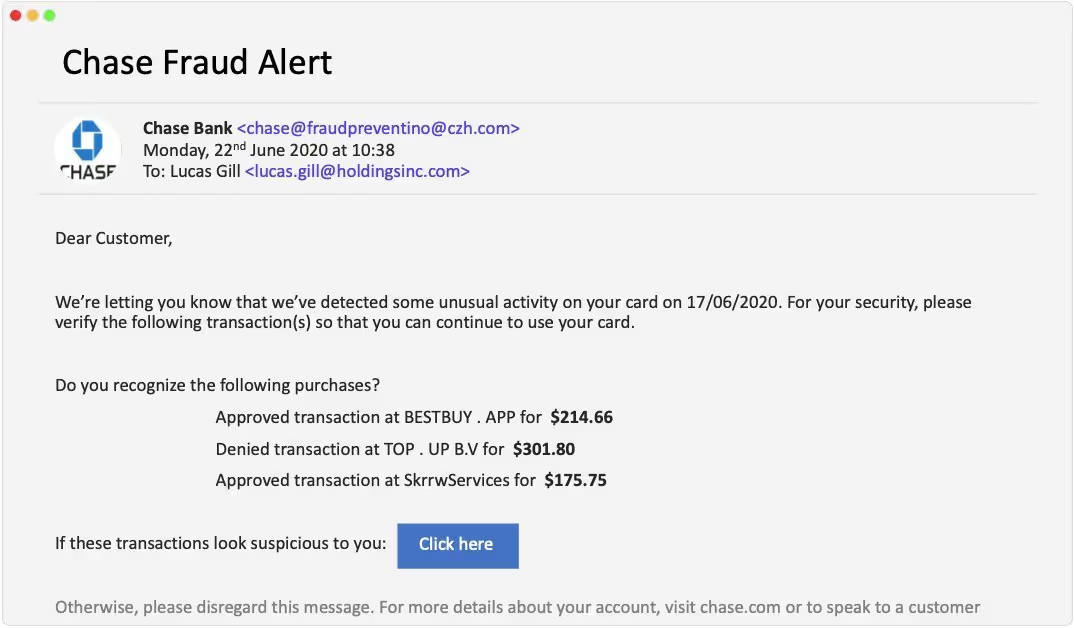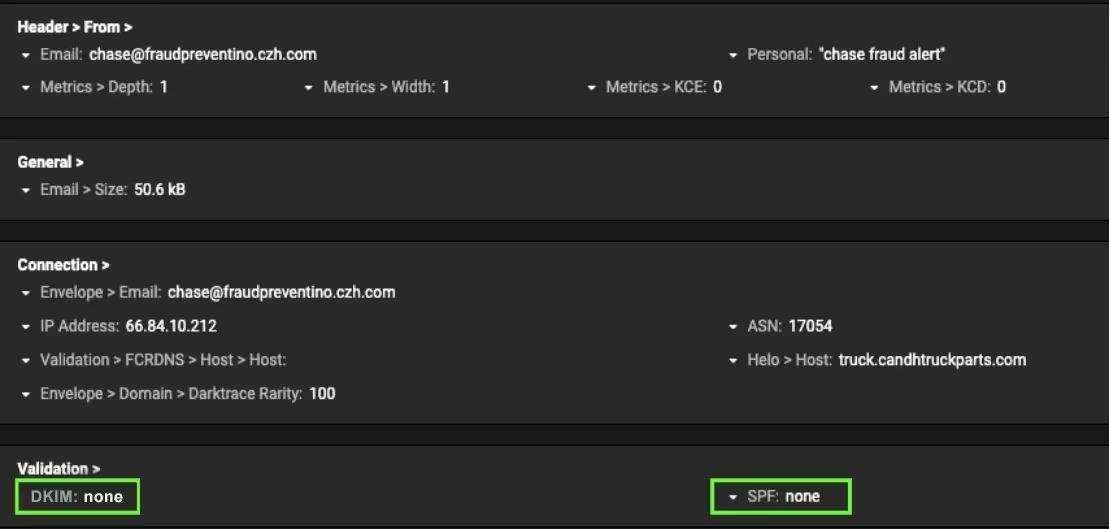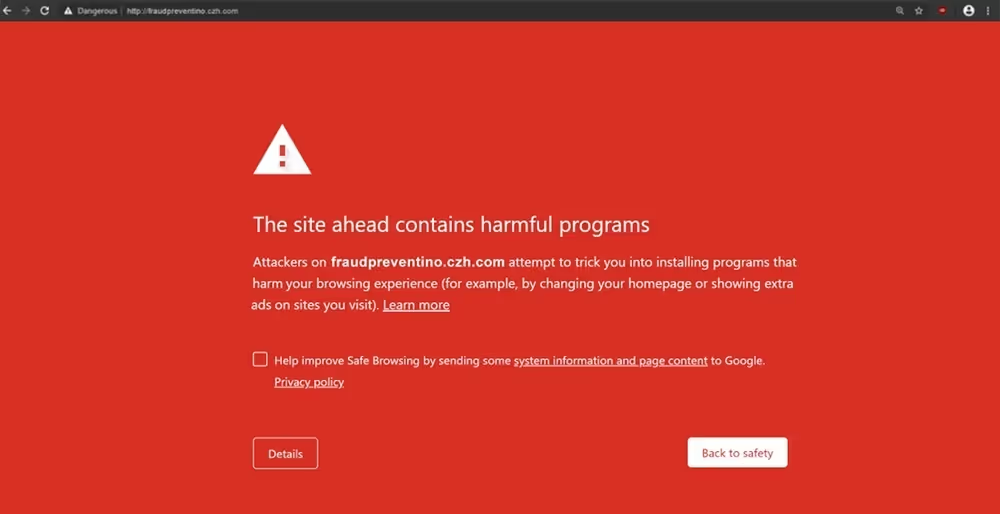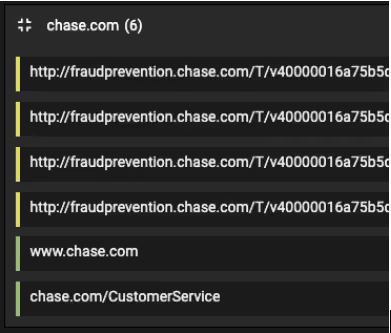In a previous blog, we analyzed a phishing attack that impersonated QuickBooks, an accounting software, in an attempt to install malware across an organization. This blog demonstrates another recent threat find where the brand of a trusted financial organization was leveraged to launch an email attack.
With an annual revenue of over $100 billion, Chase is the second largest issuer of credit cards in the US. It is unsurprising that this well-known, trusted brand is used by attackers in phishing attacks. With the recent surge in e-commerce transactions, together with increased scrutiny regarding digital security, consumers are on high-alert when it comes to the security of their banking details. A ‘fraud alert’ from a financial institution triggers stress and anxiety, and recipients may rush to take action, forgetting security training and clicking on links even if they appear to be suspicious. By playing on human emotions, attackers increase their likelihood of success.
The anatomy of an attack
An attacker appears to have invested a significant amount of research and preparation into crafting a legitimate-looking Chase fraud alert.

Figure 1: A partial recreation of the malicious email
In the phishing email above the recipient is asked to confirm that a listed transaction is legitimate. The notification, whether received through email, text message, or an app, will usually include the name of the vendor, date and time of the transaction, and the amount of money. The attacker has gone to the trouble to replicate this, listing specific suspicious transactions.
Attackers often leverage well-known brands like Chase to indiscriminately target a large pool of inboxes. They are statistically likely to find a Chase customer without having to go through the effort of actually hacking Chase’s CRM.
But while emails like these bypass legacy tools and often fool the human recipient, they are easily detected by Antigena Email’s contextual understanding of anomalous activity and stopped by its autonomous response.
How AI caught the fake fraud alert
In this case, as soon as the spoofed fraud alert hit the inbox, Antigena Email detected that the email was unusual, giving the email an 100% anomaly score.
100%
Mon Jun 22 2020, 10:38:34
From:Chase Fraud Alert <chase@fraudpreventino.czh.com>
Recipient:Kirsty Dunhill <kirsty.dunhill@holdingsinc.com>
Action Needed: Confirm you made these purchases
Email Tags
Suspicious Link
New Contact
Unknown Correspondent
Actions on Email
Lock Link
Hold Message
Figure 2: Darktrace’s AI surfacing the email as 100% anomalous
With this high anomaly score indicating a highly unusual email, Antigena Email automatically held it back from the user’s inbox.
The sender’s domain, ‘fraudpreventino’, is visually similar to ‘fraudprevention’ – the domain of the legitimate website – so the look-a-like could be easily misread as legitimate by a user.
However, in Antigena Email dashboard’s advanced tab, we see the metrics for KCE and KCD are both 0, indicating that this is a new email address that has not previously corresponded with either the recipient or anyone else within the organization. Additionally, we can see that DKIM failed and there is no SPF record, and so there were no records to validate the authenticity of the email.

Figure 3: The Threat Visualizer shows the emails have failed SPF and DKIM checks
Antigena Email detected other unusual aspects of the email indicating that it was an attack. The email contained a number of anomalous links and there was an inconsistency between the displayed link address and the actual destination of the hyperlink.
The display link in this particular email was a newly registered domain at the time the email was sent. Not surprisingly, this domain is now being identified as a malicious page. However, at the time the email was sent, the domain was not listed on ‘deny lists’ and would have slipped past spam filters or legacy security tools.
Upon clicking the link, the user would have been presented with a fraudulent Chase login screen. This is a common credential harvesting technique – when the user enters their credentials, they unknowingly hand over this information to the attacker.

Figure 4: The fake Chase login screen with credential harvesting malware
The website has now also been recognized as malicious, with users now presented with a warning encouraging them to think twice before entering sensitive information.

Figure 5: The page is later recognized as harmful by the web browser
It is not clear how long the fake login page was in existence before it was added to ‘denylists’, but what is certain is that Antigena Email was able to prevent the attack by holding back the email even without any threat intelligence on the attacker technique, ensuring no damage was done.

Figure 6: Antigena Email recognizes when a malicious link is hidden behind a misleading button
In addition to this button, the attacker also took time to add many legitimate Chase links and images. By padding the email with mostly valid content and links, the attacker attempted to deceive legacy email security tools into perceiving the email as benign. Notice below that these all link to the legitimate address for ‘fraudprevention,’ which itself was used as the source of the altered domain name for the sender.

Figure 7: The full list of links contained in the email
Defending against sophisticated phishing attacks
Attackers continue to leverage social engineering tactics to play on human error and fear in increasingly targeted phishing attacks, crafting nuanced misspellings in their domain names, padding emails with legitimate links, and creating a false sense of urgency. Self-learning AI that can spot and stop threats with both machine speed and precision becomes a critical tool at a time when humans have become even more susceptible as people’s stress and anxiety levels have become heightened by global disruption.
Of course, in this attack there is an irony in that the order of operations is directly inverted: first comes the notification, then comes the fraud. But with Antigena Email, attacks like this are stopped in their tracks, protecting employees and organizations from harm.













.jpeg)



